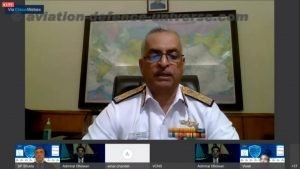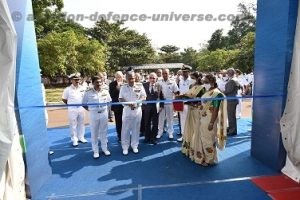
New Delhi. 23 April 2021. When recently the Ministry of Earth Sciences (MoES) rolled out the draft Blue Economy policy, inviting suggestions and inputs from various stakeholders, in line with the Government of India’s Vision of New India by 2030, the aim of India with its vast maritime interests was to reiterate that the blue economy occupies a vital potential position in India’s economic growth and it could well be the next multiplier of GDP and well-being.
Admiral G Ashok Kumar, PVSM, AVSM, VSM, ADC, Vice Chief of the Naval Staff, Indian Navy today said that the Indian Navy’s (IN) coordinated patrols with our maritime neighbours, coupled with our (the Navy’s) expeditious responses have elevated our status as a preferred security partner and first responder with the Indian Navy contributing handsomely to the responsibility of shouldering the Prime Minister‘s vision of security and growth for all in the region, or ‘SAGAR’.
India has an umbrella scheme by the name of O-SMART which aims at regulated use of oceans, marine resources for sustainable development. India has a National Fisheries policy for promoting ‘Blue Growth Initiative’ which focus on sustainable utilization of fisheries wealth from the marine and other aquatic resources. It focuses on conservation of coastal and marine resources, and improving livelihood opportunities for coastal communities etc. Sustainable Development Goal (SDG)- 14 seeks to conserve and sustainably use the oceans, seas and marine resources for sustainable development.
Addressing the valedictory session ‘Securing the Blue Economy’, organized by FICCI, Adm Kumar said a Blue Economy needs a stable and secure environment to sustain and grow. “This is enabled through an effective maritime security. With growing maritime interests, growth of our Navy is inevitable. The blue economy and maritime security are deeply intertwined and mutually dependent on each other. We will be successful in moving ahead in a cohesive and a cordinated manner with a clear-eyed focus on the greater good at the national regional and global level,” he added.
The Blue Economy aims to enhance contribution to India’s Gross Domestic Product (GDP). It comprises 4.1% of India’s economy, improve lives of coastal communities, preserve marine biodiversity and maintain the national security of marine areas and resources.
Speaking on the IN’s capability building efforts, Vice Chief of Naval Staff said that they have been a major contributor towards growth of the shipbuilding industry in the country. “Right from inception, the Indian Navy has been deeply committed towards building its platform indigenously. As on date, 39 of the 41 ships under construction are in Indian shipyards. The plough back effect towards the economy, skilling of our population in the field of ship construction, creation of jobs for axillary industries are all bound to be of positive support to the broader Blue Economic initiatives of the nation,” he said.
The policy document of the Government of India highlighted the blue economy as one of the ten core dimensions for national growth. It emphasizes policies across several key sectors to achieve holistic growth of India’s economy. It recognizes the following seven thematic areas, National accounting framework for the blue economy and ocean governance, Coastal marine spatial planning and tourism., Marine fisheries, aquaculture, and fish processing, Manufacturing, emerging industries, trade, technology, services, and skill development, Logistics, infrastructure and shipping, including trans-shipments, Coastal and deep-sea mining and offshore energy and Security, strategic dimensions, and international engagement.
Admiral R K Dhowan, (Retd), Founder and Chairperson, SAMDeS Former CNS, Indian Navy & Chairman, National Maritime Foundation said that India is essentially a maritime nation with vast maritime interests. “These maritime interests are enablers of our Blue Economy and have a vital relationship with nation’s economic growth. In the past few years, there have been a series of initiatives for the sustainable development in the maritime domain, including the quest to harness the Blue Economy,” he said.
Blue Economy emphasizes on integration of development of the ocean economy with social inclusion, environmental sustainability, combined with innovative business models. The concept was introduced by Gunter Pauli in his 2010 book- “The Blue Economy: 10 years, 100 innovations, 100 million jobs”.
Admiral Dhowan further added that there is a need to chart out a blue economy action plan at the national level for the sustainable development for our maritime interests. “We need to adopt a more integrated approach in the maritime sector and therefore, we need to have an apex level organisation to coordinate the planning processes of the various agencies and departments that operate in the maritime domain. We need to incorporate marine spatial planning so that we can optimally map our coastal areas, carry out development of our ports and harbours in a systematic manner,” he added.
Blue economy is the sustainable use of ocean resources for economic growth, improved livelihoods and jobs, and ocean ecosystem health. It advocates the greening of ocean development strategies for higher productivity and conservation of ocean’s health.
SP Shukla, Chairman, FICCI Defence and Aerospace Committee, President (Def, Aero, Agri and Steel), Member of the Group, Executive Board, Mahindra Group said that there is an enthusiasm about the growth of the Blue Economy, especially in the context of our nation. “Our thrust area is for a policy to enhance the contribution of the Blue Economy to India’s GDP; improve lives of coastal communities; preserve marine biodiversity and maintain the national security of our maritime zones. The government, multiple ministries, the Indian Navy, the Indian Coast Guard, and the Indian industry will need to come together for India to emerge as a leading blue economy of the world,” he added.
Blue economy encompasses Renewable Energy which is sustainable marine energy which can play a vital role in social and economic development, Fisheries which confirms that sustainable fisheries can generate more revenue, more fish and help restore fish stocks, Maritime Transport where over 80% of international goods traded are transported by sea, Tourism where ocean and coastal tourism can bring jobs and economic growth, Climate Change when oceans are an important carbon sink (blue carbon) and help mitigate climate change and Waste Management: Better which can help oceans recover.
Dilip Chenoy, Secretary General, FICCI said that the symposium had contributed immensely to the Prime Minister’s vision of tapping the Blue Economy. “FICCI has pioneered outreach and policy response towards this. FICCI, with its task force on Blue Economy, will continue to strive towards reaching to the potential of this sector,” he added.
Government’s Sagarmala project is the strategic initiative for port-led development through the extensive use of IT enabled services for modernization of ports. It aims at developing Inland waterways and coastal shipping which will revolutionize maritime logistics, creating million new jobs, reducing logistics costs etc. It focuses on the development of coastal communities and people in the sustainable use of ocean resources, modern fishing techniques and coastal tourism.
Reason and Need for a Blue Economy Policy in India is its vast coastline of nearly 7.5 thousand kilometers. India has a unique maritime position. Nine of its 28 states are coastal, and the nation’s geography includes 1,382 islands.There are nearly 199 ports, including 12 major ports that handle approximately 1,400 million tons of cargo each year.


























































































































